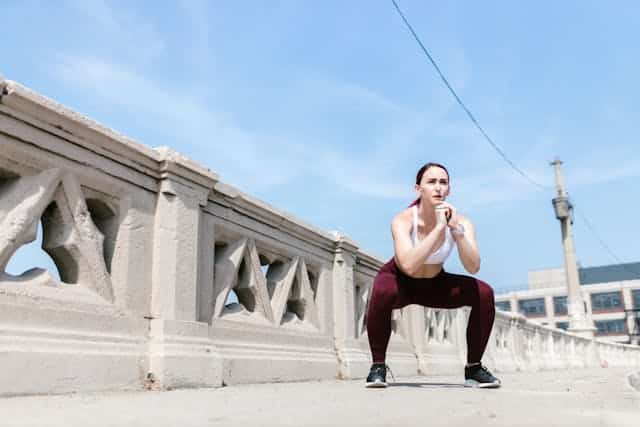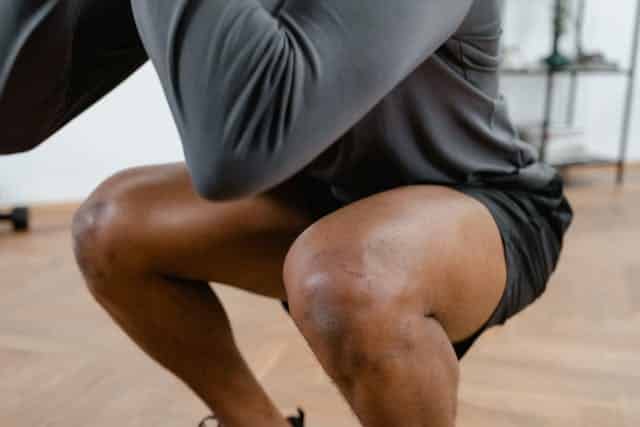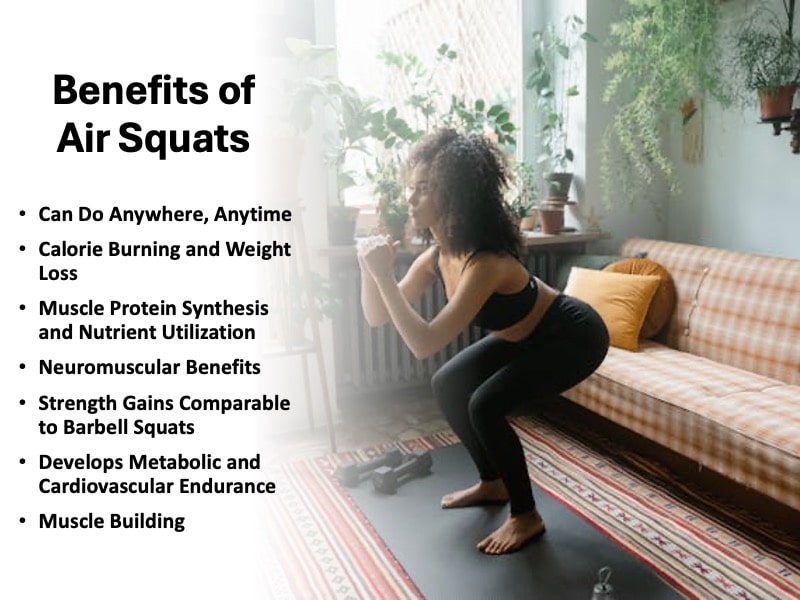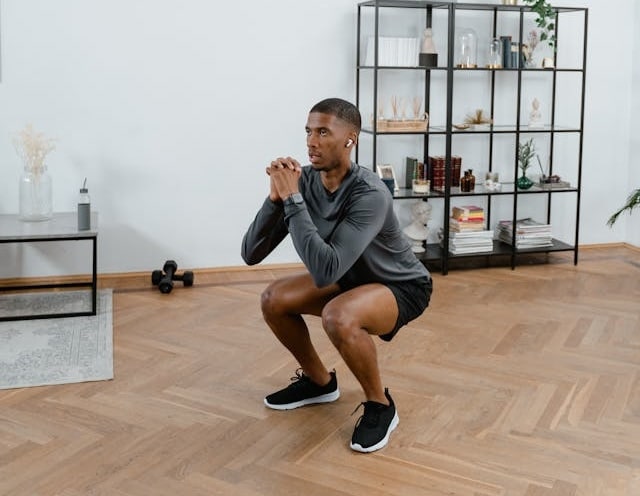Air Squats: Benefits, Muscles Worked, How to Do & More!
Air squats, also known as bodyweight squats, are a fundamental exercise that can benefit an incredibly wide range of people.
They are simple yet highly effective, requiring no equipment while offering numerous benefits.
As a professional basketball player, I’ve relied on air squats throughout my career, especially during my first year in Macedonia, when I had limited access to a weight room.
That year, I performed hundreds of air squats daily, which helped me maintain muscle mass, improve cardiovascular endurance, and improve my overall athletic abilities.
Even now, air squats are a regular part of my training, from warm-ups to high-intensity interval training (HIIT) sessions.
👉 For more exercise demonstrations, fitness tips, nutrition advice, supplement breakdowns, and athlete-tested workout plans, please subscribe to me on YouTube, where I share frequent updates and insights as a professional athlete and wellness expert.
What Are Air Squats?

Air squats are the simplest type of squats to learn and one of the best bodyweight leg exercises for building foundational strength, mobility, and muscular endurance.
Often referred to as bodyweight squats, this exercise involves lowering your hips from a standing position into a squat and then returning to the upright stance—using only your body weight as resistance.
This movement mimics everyday actions like sitting down or rising from a chair, making air squats a key functional movement pattern for people of all fitness levels.
They are commonly included in physical therapy, strength training, and athletic programs because they promote better joint mechanics, lower-body coordination, and overall balance.
As a compound bodyweight movement, air squats train multiple joints and muscle groups simultaneously, particularly targeting the hips, knees, and ankles.
Since they require no equipment, they’re accessible to beginners yet still scalable for advanced athletes through volume, tempo, or variation adjustments.
Whether you’re a beginner looking to improve daily mobility or an athlete seeking efficient lower-body conditioning, air squats deserve a place in your routine as one of the most versatile and effective bodyweight exercises available.
Air Squats Muscles Worked
The movement pattern of an air squat engages multiple muscle groups, including the quadriceps, hamstrings, glutes, and core.
It involves hip flexion, knee flexion, and ankle dorsiflexion on the descent, followed by hip and knee extension on the ascent.
- Quadriceps: The front thigh muscles that extend your knee.
- Hamstrings: The back thigh muscles that help with knee flexion and hip extension.
- Glutes: The muscles of your buttocks that drive hip extension and stability.
- Core: Although not the primary target, your core muscles stabilize your torso throughout the movement.
These muscles work together to perform the squat, making it a compound exercise that effectively builds lower body strength and stability.
How to Do Air Squats Correctly

To perform an air squat:
- Start Position: Stand with your feet shoulder-width apart, with your toes slightly pointed out (depending on tibialis/ankle/calf mobility).
- Descent: Lower your body by bending your knees and pushing your hips back like sitting in a chair. Keep your chest up, your spine neutral, and your eyes looking forward.
- Depth: Aim to lower your hips below knee level, ensuring your knees track over your toes.
- Ascent: Push through your heels to stand back up, squeezing your glutes at the top of the movement.
Tips for Proper Form
Doing bodyweight exercises like air squats is the safest option for most people, especially beginners.
However, you should still exercise caution when performing your form over time so that your body squats and you can try to improve.
You can eventually progress to additional, challenging squat variations.
- For Proper Mobility: Ensure your hips, knees, and ankles have the necessary range of motion. Regularly incorporate mobility exercises to improve your squat depth and form.
- Muscle Tissue Quality: Use foam rolling and other self-massage tools to release tight muscles and improve tissue quality, enhancing your ability to do bodyweight squats.
Focusing on these aspects will help you perform bodyweight squats more effectively, leading to better results in your overall fitness.
Common Mistakes to Avoid
- Knee Valgus: Don’t let your knees collapse inward; keep them aligned with your toes.
- Rounded Back: Maintain a neutral spine to avoid undue stress on your lower back.
- Heels Lifting: Keep your heels grounded throughout the movement to ensure proper muscle activation.
Benefits of Air Squats

Air squats are a highly effective and accessible exercise with benefits that extend beyond simple lower-body strengthening.
Their impact on muscle protein synthesis, neuromuscular efficiency, metabolic health, and overall fitness makes them a valuable addition to any workout routine.
Research highlights their role in muscle growth, cardiovascular endurance, and functional movement, making them suitable for a wide range of individuals, from athletes to older adults.
Personally, air squats have played a vital role in my personal training, particularly during times when I lacked access to traditional gym equipment.
Even now, I integrate them into my warm-ups, Tabata workouts, and CrossFit-style circuits due to their versatility and efficiency.
Whether used for muscle maintenance, cardiovascular conditioning, or functional movement, air squats remain one of the most effective bodyweight exercises available.
Can Do Anywhere, Anytime
One of the greatest advantages of air squats is their unmatched accessibility—they require no equipment, no gym, and barely any space.
Whether you’re traveling, short on time, or just taking a break from work, air squats can be performed virtually anywhere. This makes them an ideal choice for busy professionals, students, or anyone without consistent access to a fitness facility.
Air squats even function exceptionally well as an “activity snack,” a growing concept in exercise science that encourages breaking up long periods of sedentary behavior with short bursts of physical movement (Moore et al., 2022).
A quick set during a work break can increase blood flow, elevate heart rate, and re-engage your muscles—helping combat the negative effects of prolonged sitting.
They’re a practical tool for integrating more physical activity into your daily life without the need for structured workouts.
Calorie Burning and Weight Loss
Air squats provide a moderate calorie burn, making them a useful exercise for endurance training and fat loss when incorporated into high-intensity routines.
Research on bodyweight exercises estimates that air squats performed at a moderate pace burn approximately 2.7 kcal per minute (Nakagata et al., 2022).
While this may be lower than high-resistance movements, the ability to perform high-rep sets or incorporate bodyweight squats into circuit training increases their overall effectiveness for energy expenditure.
Muscle Building
Although air squats are performed without external resistance, they are still highly effective for stimulating muscle growth, particularly when executed at higher volumes or with controlled tempo.
As a compound movement, air squats recruit multiple major muscle groups—especially the quadriceps, glutes, and hamstrings—creating enough mechanical tension and metabolic stress to support hypertrophy over time.
For beginners or those returning to training after a break, air squats can help build muscle mass while improving neuromuscular coordination.
For advanced individuals, programming techniques such as slow eccentrics, pauses, or progressing to weighted squats and single-leg variations (e.g., pistol squats) can further support muscular development.
When paired with adequate protein intake and recovery, bodyweight squats can meaningfully contribute to lower-body strength and muscle maintenance, particularly during periods without access to weights.
Increased Muscle Protein Synthesis and Nutrient Utilization
Air squats improve muscle protein synthesis by increasing amino acid uptake, particularly when used as a method to break up prolonged sedentary behavior.
Research has demonstrated that performing them intermittently throughout the day significantly improves the efficiency of dietary amino acid utilization for muscle contractile protein synthesis (Moore et al., 2022).
This suggests that even without added weight, bodyweight squats can contribute to maintaining and building muscle, especially when combined with proper nutrition.
Neuromuscular Improvements
Air squats can improve neuromuscular efficiency by enhancing motor unit recruitment and coordination.
A study examining the effects of high-repetition bodyweight squats in older adults found that while there were no significant increases in muscle mass or strength, there were improvements in neural activation patterns (Hirono et al., 2023).
This suggests that air squats may be beneficial for maintaining motor control and movement efficiency, though additional resistance may be needed to achieve significant muscle hypertrophy.
Strength Gains Comparable to Barbell Squats
When programmed progressively, air squats can match barbell squats in terms of lower-body strength and hypertrophy.
Research comparing progressive bodyweight squats to barbell back squats found that both methods led to significant improvements in knee extensor and flexor strength, as well as muscle thickness in the gluteus maximus and rectus femoris (Wei et al., 2023).
However, back squats were more effective for reducing body fat, likely due to the increased metabolic demands of heavier resistance training.
Incorporating unilateral bodyweight leg exercises, such as Bulgarian split squats and pistol squats, further supports effective building of lower-body strength without external resistance.
Better Metabolic Health
While a single session of air squats may not drastically shift 24-hour blood glucose levels in healthy adults, consistent training can still provide meaningful benefits for metabolic health (Babir et al., 2023).
Bodyweight exercises like air squats stimulate large muscle groups and improve glucose uptake in skeletal muscle, which over time may improve insulin sensitivity and support long-term glycemic control.
Performed regularly and at moderate to high intensity, air squats can serve as a simple and effective metabolic conditioning tool for promoting metabolic flexibility, especially for individuals with sedentary lifestyles or elevated risk of metabolic dysfunction.
Improved Cardiovascular Endurance
Air squats elevate heart rate rapidly and can help develop cardiovascular endurance when performed in high-repetition sets or as part of a circuit.
In the study by Babir et al. (2023), participants performing a short bodyweight workout including bodyweight squats reached an average of 75% of their age-predicted maximum heart rate, well within the vigorous exercise range.
This makes air squats an accessible option for improving aerobic capacity, especially when equipment is limited.
With consistent practice, they can improve muscular endurance, circulation, and overall heart health in a time-efficient way.
Supports Longevity and Healthy Aging
While often associated with athletic training or high-intensity workouts, air squats are equally powerful as a tool for healthy aging and maintaining independence later in life.
Research shows that lower-body strength and mobility are key predictors of fall risk, functional independence, and even mortality in older adults (Granacher et al., 2013).
By strengthening the glutes, quadriceps, and hip stabilizers, air squats improve balance, coordination, and the ability to perform daily tasks like standing from a chair or climbing stairs.
Because they promote joint mobility and neuromuscular control without excessive strain, air squats are ideal for aging populations seeking to stay active and mobile.
Incorporating a few sets of bodyweight squats into a daily or weekly routine can help preserve muscle mass, increase bone density through weight-bearing movement, and reduce the risk of injury.
As a low-impact and easily modifiable exercise, they’re an effective entry point for older adults returning to movement after inactivity or injury.
Best Air Squat Workouts
Air squats are highly adaptable to various workout styles. Here are some of my favorite options which I believe are the best air squat workouts:
EMOM (Every Minute on the Minute)
I frequently use bodyweight squats in EMOM (Every Minute on the Minute) workouts, where you perform a set number of squats at the start of every minute and use the remaining time to recover.
This format pushes your cardiovascular system and muscular endurance, ensuring you maximize your workout in a short period.
The most I ever worked up to was 25 air squats every minute on the minute for 25 minutes.
This challenging workout tested my physical endurance and mental toughness, requiring sustained effort and focus throughout.
Tabata
Another of my favorite air squat workouts is the Tabata interval workout, which involves 20 seconds of all-out effort followed by 10 seconds of rest, repeated for eight rounds.
Air squats are perfect for this high-intensity protocol because they can be done quickly and with minimal setup, allowing you to maintain a high heart rate and build muscular endurance.
CrossFit Workouts
Additionally, I love incorporating air squats into 21-15-9 circuits, which are a CrossFit staple.
In this format, you perform 21 reps of air squats followed by 21 reps of another exercise, such as pushups or sit-ups.
You then move on to 15 reps of each, and finally, nine reps.
This descending rep scheme challenges your muscles and tests your mental toughness as you endure fatigue.
How Many Air Squats Should You Do a Day?
If you are wondering how many squats you should do a day, the ideal number of air squats to perform daily depends on your fitness level, training goals, and recovery capacity.
There’s no one-size-fits-all answer, but general guidelines can help you find the right volume.
- For beginners, starting with 2–3 sets of 10–15 reps per day is an effective way to build consistency and improve movement mechanics.
- As your strength and endurance improve, you can gradually increase to 50–100 total reps per day, either broken into smaller sets throughout the day or completed in a single workout.
- If you’re using air squats for general fitness, weight loss, or as part of a mobility routine, daily squatting can be beneficial—especially when integrated into high-intensity circuits or “activity snacks” spread across the day.
- For building muscle or improving lower-body strength, more targeted programming (such as 3–4 squat-focused workouts per week) with progressive overload may be more effective.
In my own training, I’ve used daily air squats during travel or injury recovery phases to maintain muscle tone and cardiovascular conditioning.
Whether you’re doing 20 squats during a break from your desk or 200 squats in a structured EMOM session, consistency and quality of movement are more important than hitting a specific number.
Final Thoughts: Are Air Squats Good for You?

Air squats are one of the most effective bodyweight exercises for improving lower-body strength, mobility, and muscular endurance—regardless of age or fitness level.
Their simplicity makes them accessible to beginners, while their adaptability allows athletes to continually challenge themselves through volume, tempo, or unilateral variations.
From my own experience as a professional basketball player, bodyweight squats have been essential during times when access to a weight room wasn’t possible.
Whether used to maintain strength, promote athleticism, or improve metabolic health, they’re a reliable tool that consistently delivers results.
Because they require no equipment, can be done anywhere, and offer full-body benefits when performed with proper form, air squats are not only good for you—they’re essential for building a strong, functional, and resilient body.’
Frequently Asked Questions About Air Squats
This website does not provide medical advice. This website site does contain affiliate links, and purchases may earn a commission.
Read my Medical Disclaimer, Review Disclaimer, and Publishing Policies for more details. Use of this site indicates acceptance of these terms.



